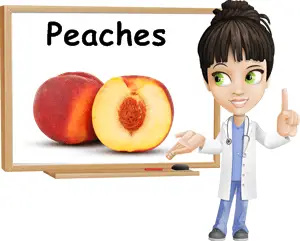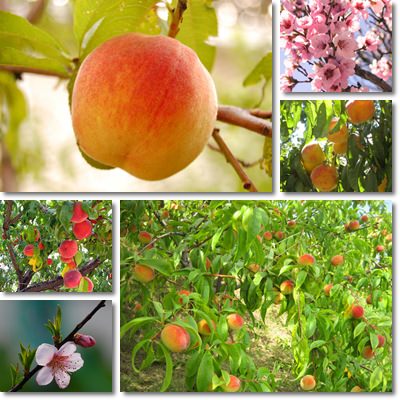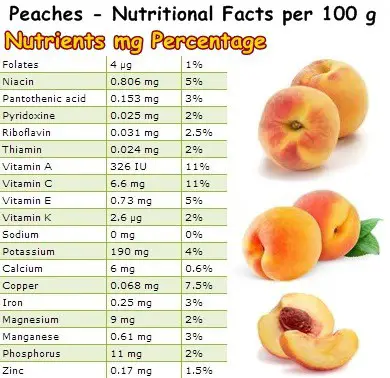In Chinese art and culture, peaches (Prunus persica) are seen as a symbol of immortality. It was said that the fruit had magical powers and it bestowed infinite life on whoever ate them. Chinese emperors used to give their immortal gods ‘peaches of immortality’ as offerings so as to ensure they had everlasting life. For this reason, the fruit is commonly depicted in many Chinese writings as well as various forms of Chinese art.
Maybe we too should eat more peaches seen that they were the ambrosia of Chinese deities.
While eating a peach or a few of them doesn’t actually add 1,000 years to our life, they are indeed a nutritious fruit which can certainly contribute to a considerable increase in life span, when part of a varied, balanced and nutritious diet. While they are not highly nutritious themselves, boasting a modest nutritional profile, they are a source of essential vitamins and minerals as well as antioxidants with therapeutic properties.

Peach facts and trivia
Fact no. 1:
As you may have guessed already, peaches originate in China, from where they spread to Persia and then other parts of the world. The scientific name of peaches is Prunus persica, the second name indicating a Persian origin (now believed to be incorrect). The peach tree slowly started gaining popularity and nowadays is cultivated throughout the world.
Fact no. 2:
A second interesting fact about peaches is that the tree requires a minimum period of cold weather, estimated at an average of around 500 hours at less than 10 degrees Celsius. Some cultivars require less chilling, others more. If the tree doesn’t get its cold time, it may not blossom and produce any fruit at all. If it doesn’t get enough chilling time, the peach tree produces very few fruit of very low quality.
Fact no. 3:
A third interesting fact about peaches is that they are one of the first trees to blossom in spring, which also puts them at risk of being affected by spring frosts. The more developed the flower buds and the lower the temperatures, the more likely and severe the frost damage.
Fact no. 4
A fourth interesting fact is that peaches can be clingstone, freestone or a variety in between called semi-freestone or semi-clingstone. These denominations refer to how well the stone containing the seed can be removed from the peach. And for the last peach trivia piece of information: peaches and nectarines are essentially the same fruit, more exactly the nectarine is a type of peach.

Peach types and varieties
There are three varieties of the Prunus persica species: peaches (clingstone, freestone and semi-freestone, with white or yellow-flesh), nectarines and peacherines.
What do peaches look like?
Peaches are the original fruit. Depending on cultivar and growing conditions, the fruit is usually the size of a medium or large apple and round-shaped. There is also a special variety of flat peach that looks similar to a cube. Each fruit has a fine line or crease on one side separating what looks like two parts of the fruit. The skin is thin and leathery, covered in tiny, whitish hairs making up a velvety-textured fuzz.
What do peaches taste like?
The flesh is generally succulent, firm and delicate, with subtle sweet flavors. Flesh color is either yellow or white with deep red tones in the center where the stone is. Peaches have one relatively large, red-brown stone or pit containing an oval, brown seed with a milky white interior. The pit is located in the center of the fruit and has multiple, deep, asymmetrical indentations.
Clingstone peaches have a pit that is difficult to remove, causing some flesh to also be discarded in the process. Freestone peaches have a pit that is easily removed from the flesh, without losing too much fruit flesh. Semi-freestone varieties are somewhere in between.
(2) Nectarines
A variety of peach with no fuzz. Most cultivars have a soft skin, juicy yellow or white flesh and rich flavor profile with a savory peach perfume. Can be clingstone, freestone or semi-freestone.
See the benefits of nectarines.
(3) Peacherines
A variety with both peach and nectarine characteristics, white or yellow flesh and typical peach flavor profile. Not always considered a distinct type or variety of peach.
What kind of fruit is the peach from a nutritional point of view? Each variety of the fruit has not only slightly different characteristics, but also comes with slight differences in nutritional profile. For example, the yellow-flesh fruits can have more pigmented antioxidants than the white-flesh fruits, notably the vitamin A precursor beta-carotene. Similarly, the more blush on the skin, the higher the content of antioxidant anthocyanins. The sweeter the fruit, the higher the sugar content. The more acidic or sour the taste, the more vitamin C. So no two fruits will provide the exact same nutrition, but rather a similar one.

Peach nutrition facts
The fruit provides small amounts of 19 out of 30 essential vitamins and dietary minerals. It’s richest in vitamins C and E and potassium. 100 g of peaches has 39 kcal, 9.5 g of carbohydrates, out of which 8.4 g are sugars, 1.5 g of dietary fiber, less than 0.3 g of fat and less than 1 g of protein.
What vitamins do peaches have?
100 g of peach contains less than 10% of the recommended daily allowance of vitamins A (16 mcg from the antioxidant beta-carotene), B1 (0.024 mg, B2 (0.031 mg), B3 (0.806 mg), B5 (0.153 mg), B6 (0.025 mg), B9 (4 mcg), choline (6.1 mg) and vitamins C (6.6 mg), E (0.73 mg) and K (2.6 mcg).
What minerals do peaches have?
100 g of peach contains less than 10% of the RDA of the following dietary minerals: calcium (6 mg), iron (0.25 mg), magnesium (9 mg), manganese (0.061 mg), phosphorus (20 mg), potassium (190 mg), zinc (0.17 mg), no sodium.
What antioxidants do peaches have?
Beta-carotene, a vitamin A precursor in yellow-flesh peaches and nectarines (an average of 162 mcg/100 g). Other antioxidants in peaches: chlorogenic acid, epicathechin, catechins, rutin, isoquerceting, gallic and ellagic acids.
What are peaches good for?
Despite the low content of vitamins and minerals, peaches provide the following health benefits:
Antioxidant benefits
Peaches are a good source of potent antioxidants such as vitamins C and E. They may contain a variety of phytochemicals such as neochlorogenic acid and chlorogenic acid, catechin, epicatechin, gallic acid and ellagic acid, beta-carotene and anthocyanins. Antioxidants protect against harmful free radicals, reactive oxygen molecules responsible for oxidative stress, a process which can cause irreparable damage to cells and DNA and, at a higher level, mucous membranes, internal organs and whole systems, interfering with the overall good functioning of our body and producing disease. A diet rich in fruits like peaches, vegetables and plant products in general can help boost general health and reduce the risks of chronic disease.
Antibacterial and anti-inflammatory properties
Famous for its highly beneficial effects on human health, vitamin C is a strong natural antibacterial in peaches, efficient against infections of all sorts. An intake of at least 500 to 1.000 mg (1 g) of vitamin C a day can help reduce the frequency, duration and severity of respiratory infections. Furthermore, vitamin C is reported to help improve arthritis pain and reduce swelling in joints as well as prevent scurvy and gum disease. Although low in the vitamin, peaches are worth including in our diets.
Anti-aging properties
In addition to anti-inflammatory properties which contribute to inflammation control, vitamin C also helps reduce bacteria populations on skin, potentially contributing to better acne control if used directly on the skin. Vitamin C is also the basis for collagen production which promotes skin repair and further ensures the youthful appearance of our skin. As an antioxidant, it is also equipped in seeking and destroying free radicals and reducing damage to skin. Peaches are also good for skin thanks to their content of vitamin E which helps skin cells retain moisture as well as protects against free radical damage. Using a peach and honey mask can help improve overall skin appearance.
Minor benefits for vision and skin, lungs and immunity
Peaches contain small amounts of vitamin A from the antioxidant beta-carotene. The vitamin acts on multiple systems and provides benefits for vision, skin, respiratory system and immune system. Vitamin A protects against degenerative eye diseases and maintains skin integrity, not to mention boosts immunity by reducing the risk of bacterial infections. Studies show the consumption of foods rich in vitamin A provides protection against lung and mouth cancers. In order to make the vitamin A in peaches bioavailable, the fruit need to be eaten with a little fat.
Cardiovascular benefits
The fruit provides small amounts of potassium, magnesium as well as B vitamins, vitamin C and dietary fiber, all important for good cardiovascular health. Eating peaches is primarily good for high blood pressure. Because of the potassium content which helps regulate body fluids, the fruit produces minor beneficial effects on heart rate and blood pressure. Magnesium and B vitamins maintain the health of the heart muscle. Vitamin C is beneficial for blood clotting. Dietary fiber limits fats absorption and helps manage weight for better cardiovascular health.
Also note in the nutritional table above the presence of potassium, magnesium, manganese, copper, calcium, iron, zinc and phosphorous.
Other benefits of peaches
With the small amounts of different vitamins and minerals they provide, peaches contribute to various other health benefits. Magnesium is important for the proper integration of calcium in bones and is beneficial for practically every muscle in our body including the biggest, most important muscle in our body which is the heart. Together with B vitamins, it supports nervous system health. Iron is essential managing anemia or reducing fatigue, while vitamin C helps absorb the iron and has antibacterial and anti-inflammatory properties.
Copper sustains important enzymatic processes as well as iron metabolism and prevents premature hair graying and eye discoloration. Vitamin K contributes to blood coagulation, manganese is an antioxidant and anti-inflammatory, while phosphorus together with magnesium and calcium strengthens bones. And with only 39 kcal/100 g, peaches are extremely figure-friendly.
What kind of fruit is the peach?
One whose nutrition contributes to the immune and nervous systems, bone frame, skin health, vision, respiratory system, weight loss and energy metabolism. And you can dry peaches, even at home in the oven to make more long-lasting snacks with concentrated nutrition. The major difference between fresh and dried peaches is that the vitamin C is lost in the dry fruit. Also read: Can diabetics eat peaches?
Peaches side effects and risks
Although rare and associated with innate sensitivities or improper use of various parts of the fruit species, there are two major side effects to consider:
Peach allergy
For the most part, fresh peaches hold a risk for allergic reactions with symptoms ranging from skin effects (redness, itching, bumps) to itchy throat and mouth, tongue and throat swelling, difficulty breathing, gastrointestinal upset (nausea, diarrhea) and more severe symptoms such as anaphylactic shock. People allergic to related fruits such as almonds, apricots, cherries and plums may also have a higher risk for peach allergy. Canned or cooked peaches (stewed or baked in peach cobbler) may not elicit allergic reactions compared to the fresh fruit. If allergic, it is best to avoid the fruit in all forms.
Peach pits toxicity
Because peaches belong to the Rosaceae family, genus Prunus, their seeds are a source of hydrogen cyanide, similar to those of related fruits. Although ingesting a peach seed may not produce any ill effects, it’s wise not to eat any seeds because they hold great toxic potential. The myth that they contain a type of B vitamin which can cure cancer is nothing but a myth and the reason why so many people who have eaten apple pips, cherry, peach or apricot seeds have gotten ill.
